Develop a Profitable B2B Enterprise by Initially Attracting and Engaging Customers
In the rapidly evolving world of healthcare, a less-discussed yet promising business model is gaining traction: the Business-to-Consumer-to-Business (B2C2B) model. This strategy, which involves engaging consumers first and leveraging their engagement to create value for businesses, is particularly effective in areas such as telehealth, wellness coaching, and digital health platforms.
### The Power of Engagement in B2C2B
The B2C2B model thrives on consumer engagement, building trust and demand among patients to demonstrate real-world usage and benefits. By offering easy-to-use, HIPAA-compliant digital health tools or services and focusing on niche patient populations or specific health conditions, companies can deliver targeted value to consumers. This, in turn, makes their offerings attractive to businesses such as employers, insurers, or healthcare providers who are seeking to offer innovative solutions to their clients.
### Data and Insights: The Goldmine of B2C2B
Consumer interactions generate valuable health data and behavioural insights that can be packaged into business solutions. By leveraging technology, companies can track user engagement and health outcomes, creating compelling selling points for businesses. AI-powered analytics, for instance, can provide invaluable insights into consumer behaviour and health trends, helping businesses make informed decisions.
### Strategies for B2C2B Success in Healthcare
1. Building Strong Consumer Trust and Value: Offer consumer-friendly digital health tools, focus on niche populations, and use tailored marketing strategies to grow consumer awareness and adoption.
2. Leveraging Technology for Seamless Experiences: Implement secure messaging, scheduling, and clinical documentation systems to support consumer interactions and business integration. AI-powered analytics can track user engagement and health outcomes, providing valuable insights to businesses.
3. Flexible Pricing and Revenue Models: Consider hybrid revenue models that combine direct-pay from consumers with insurance reimbursement or employer contracts. Pricing strategies should reflect consumer willingness to pay while aligning with business clients' budgets.
4. Demonstrating Clear ROI for Businesses: Collect and present data on improved health outcomes, reduced absenteeism, or lower healthcare costs derived from consumer use. Package consumer insights into actionable business solutions such as employee wellness programs or risk management tools.
5. Partnering with Employers and Insurers: After building a sizable and engaged consumer base, actively develop partnerships with businesses that benefit from healthier populations. Use consumer feedback to customise offerings that meet business clients’ specific needs.
### The B2C2B Model in Action
Companies like Calm, TalkSpace, and Noom initially focused on direct-to-consumer models but have since expanded to the B2C2B model, partnering with employers and insurers to offer their services to a wider audience. NOCD, a virtual care company focusing on obsessive-compulsive disorder, is an example of the B2C2B model's success. By building communities of users and offering free content to engage and inform, NOCD has boosted its organisation's visibility and attracted business partnerships.
In conclusion, while explicit data on B2C2B’s quantitative effectiveness in healthcare is limited, the model aligns well with current trends emphasising patient-centred care, data-driven insights, and digital health expansion. Companies that strategically build consumer trust and engagement, leverage technology, and then convert that into business value have the highest chance of success in this model. By focusing on consumer experience first and then demonstrating validated outcomes and ROI, healthcare companies can effectively implement B2C2B strategies to drive growth and impact.
The B2C2B model, by focusing on consumer engagement and offering user-friendly digital health tools, can create valuable data and insights, making these attractively packaging for businesses in areas like telehealth, wellness coaching, and digital health platforms. Leveraging technology, companies can track consumer engagement and health outcomes, providing compelling selling points for employers, insurers, or healthcare providers.
By partnering with businesses that benefit from healthier populations, such as employers and insurers, companies can expand their reach beyond direct-to-consumer models, as illustrated by firms like Calm, TalkSpace, and Noom, which have found success in the B2C2B model. NOCD, a virtual care company focused on obsessive-compulsive disorder, exemplifies the B2C2B model's success by building communities of users, offering free content, and attracting business partnerships.




